数字图像处理领域的二十四个典型算法及vc实现、
作者:July 二零一一年二月二十六日。
参考:百度百科、维基百科、vc数字图像处理。
--------------------------------------------------
数字图像处理领域的二十四个典型算法及vc实现、第一章
一、256色转灰度图
二、Walsh变换
三、二值化变换
四、阈值变换
五、傅立叶变换
六、离散余弦变换
数字图像处理领域的二十四个典型算法及vc实现、第二章
七、高斯平滑
八、图像平移
九、图像缩放
十、图像旋转
数字图像处理领域的二十四个典型算法及vc实现、第三章
图像处理,是对图像进行分析、加工、和处理,使其满足视觉、心理以及其他要求的技术。图像处理是信号处理在图像域上的一个应用。目前大多数的图像是以数字形式存储,因而图像处理很多情况下指数字图像处理。
本文接下来,简单粗略介绍下数字图像处理领域中的24个经典算法,然后全部算法用vc实现。由于篇幅所限,只给出某一算法的主体代码。
ok,请细看。
一、256色转灰度图
算法介绍(百度百科):
什么叫灰度图?任何颜色都有红、绿、蓝三原色组成,假如原来某点的颜色为RGB(R,G,B),那么,我们可以通过下面几种方法,将其转换为灰度:
1.浮点算法:Gray=R*0.3+G*0.59+B*0.11
2.整数方法:Gray=(R*30+G*59+B*11)/100
3.移位方法:Gray =(R*28+G*151+B*77)>>8;
4.平均值法:Gray=(R+G+B)/3;
5.仅取绿色:Gray=G;
通过上述任一种方法求得Gray后,将原来的RGB(R,G,B)中的R,G,B统一用Gray替换,形成新的颜色RGB(Gray,Gray,Gray),用它替换原来的RGB(R,G,B)就是灰度图了。
灰度分为256阶。所以,用灰度表示的图像称作灰度图。
程序实现:
ok,知道了什么叫灰度图,下面,咱们就来实现此256色灰度图。
这个Convert256toGray(),即是将256色位图转化为灰度图:
voidConvert256toGray(HDIB hDIB)
{
LPSTRlpDIB;
// 由DIB句柄得到DIB指针并锁定DIB
lpDIB = (LPSTR) ::GlobalLock((HGLOBAL)hDIB);
// 指向DIB象素数据区的指针
LPSTR lpDIBBits;
// 指向DIB象素的指针
BYTE *lpSrc;
// 图像宽度
LONGlWidth;
// 图像高度
LONG lHeight;
// 图像每行的字节数
LONGlLineBytes;
// 指向BITMAPINFO结构的指针(Win3.0)
LPBITMAPINFO lpbmi;
// 指向BITMAPCOREINFO结构的指针
LPBITMAPCOREINFO lpbmc;
// 获取指向BITMAPINFO结构的指针(Win3.0)
lpbmi = (LPBITMAPINFO)lpDIB;
// 获取指向BITMAPCOREINFO结构的指针
lpbmc = (LPBITMAPCOREINFO)lpDIB;
// 灰度映射表
BYTE bMap[256];
// 计算灰度映射表(保存各个颜色的灰度值),并更新DIB调色板
inti,j;
for (i = 0; i < 256; i ++)
{
// 计算该颜色对应的灰度值
bMap[i] = (BYTE)(0.299 * lpbmi->bmiColors[i].rgbRed +
0.587 * lpbmi->bmiColors[i].rgbGreen +
0.114 * lpbmi->bmiColors[i].rgbBlue + 0.5);
// 更新DIB调色板红色分量
lpbmi->bmiColors[i].rgbRed = i;
// 更新DIB调色板绿色分量
lpbmi->bmiColors[i].rgbGreen = i;
// 更新DIB调色板蓝色分量
lpbmi->bmiColors[i].rgbBlue = i;
// 更新DIB调色板保留位
lpbmi->bmiColors[i].rgbReserved = 0;
}
// 找到DIB图像象素起始位置
lpDIBBits = ::FindDIBBits(lpDIB);
// 获取图像宽度
lWidth = ::DIBWidth(lpDIB);
// 获取图像高度
lHeight = ::DIBHeight(lpDIB);
// 计算图像每行的字节数
lLineBytes = WIDTHBYTES(lWidth * 8);
// 更换每个象素的颜色索引(即按照灰度映射表换成灰度值)
//逐行扫描
for(i = 0; i < lHeight; i++)
{
//逐列扫描
for(j = 0; j < lWidth; j++)
{
// 指向DIB第i行,第j个象素的指针
lpSrc = (unsigned char*)lpDIBBits + lLineBytes * (lHeight - 1 - i) + j;
// 变换
*lpSrc = bMap[*lpSrc];
}
}
//解除锁定
::GlobalUnlock ((HGLOBAL)hDIB);
}
变换效果(以下若无特别说明,图示的右边部分都是为某一算法变换之后的效果):

二、Walsh变换
算法介绍:
有关Walsh变换的深入介绍,请看此论文:http://www.informatics.org.cn/doc/ucit200510/ucit20051005.pdf
程序实现:
函数名称:WALSH()
参数:
double * f- 指向时域值的指针
double * F- 指向频域值的指针
r-2的幂数
返回值:无。
说明:该函数用来实现快速沃尔什-哈达玛变换。
VOID WINAPIWALSH(double *f, double *F, int r)
{
// 沃尔什-哈达玛变换点数
LONGcount;
// 循环变量
inti,j,k;
// 中间变量
intbfsize,p;
double *X1,*X2,*X;
// 计算快速沃尔什变换点数
count = 1 << r;
// 分配运算所需的数组
X1 = new double[count];
X2 = new double[count];
// 将时域点写入数组X1
memcpy(X1, f, sizeof(double) * count);
// 蝶形运算
for(k = 0; k < r; k++)
{
for(j = 0; j < 1<<k; j++)
{
bfsize = 1 << (r-k);
for(i = 0; i < bfsize / 2; i++)
{
p = j * bfsize;
X2[i + p] = X1[i + p] + X1[i + p + bfsize / 2];
X2[i + p + bfsize / 2] = X1[i + p] - X1[i + p + bfsize / 2];
}
}
// 互换X1和X2
X = X1;
X1 = X2;
X2 = X;
}
// 调整系数
for(j = 0; j < count; j++)
{
p = 0;
for(i = 0; i < r; i++)
{
if (j & (1<<i))
{
p += 1 << (r-i-1);
}
}
F[j] = X1[p] / count;
}
// 释放内存
delete X1;
delete X2;
}
函数名称:DIBWalsh1()
参数:
LPSTR lpDIBBits - 指向源DIB图像指针
LONG lWidth - 源图像宽度(象素数)
LONG lHeight - 源图像高度(象素数)
返回值:BOOL - 成功返回TRUE,否则返回FALSE。
说明:该函数用来对图像进行沃尔什-哈达玛变换。于上面不同的是,此处是将二维
矩阵转换成一个列向量,然后对该列向量进行一次一维沃尔什-哈达玛变换。
BOOL WINAPIDIBWalsh1(LPSTR lpDIBBits, LONG lWidth, LONG lHeight)
{
// 指向源图像的指针
unsigned char*lpSrc;
// 循环变量
LONGi;
LONGj;
// 进行付立叶变换的宽度和高度(2的整数次方)
LONGw;
LONGh;
// 中间变量
doubledTemp;
intwp;
inthp;
// 图像每行的字节数
LONGlLineBytes;
// 计算图像每行的字节数
lLineBytes = WIDTHBYTES(lWidth * 8);
// 赋初值
w = 1;
h = 1;
wp = 0;
hp = 0;
// 计算进行离散余弦变换的宽度和高度(2的整数次方)
while(w * 2 <= lWidth)
{
w *= 2;
wp++;
}
while(h * 2 <= lHeight)
{
h *= 2;
hp++;
}
// 分配内存
double *f = new double[w * h];
double *F = new double[w * h];
// 列
for(i = 0; i < w; i++)
{
// 行
for(j = 0; j < h; j++)
{
// 指向DIB第j行,第i个象素的指针
lpSrc = (unsigned char*)lpDIBBits + lLineBytes * (lHeight - 1 - j) + i;
// 给时域赋值
f[j + i * w] = *(lpSrc);
}
}
// 调用快速沃尔什-哈达玛变换
WALSH(f, F, wp + hp);
// 列
for(i = 0; i < w; i++)
{
// 行
for(j = 0; j < h; j++)
{
// 计算频谱
dTemp = fabs(F[i * w + j] * 1000);
// 判断是否超过255
if (dTemp > 255)
{
// 对于超过的,直接设置为255
dTemp = 255;
}
// 指向DIB第j行,第i个象素的指针
lpSrc = (unsigned char*)lpDIBBits + lLineBytes * (lHeight - 1 - j) + i;
// 更新源图像
* (lpSrc) = (BYTE)(dTemp);
}
}
//释放内存
delete f;
delete F;
// 返回
return TRUE;
}
变换效果:
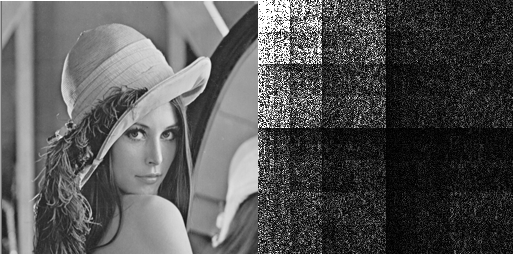
三、二值化变换
算法描述:
二值化是图像分割的一种方法。在二值化图象的时候把大于某个临界灰度值的像素灰度设为灰度極大值,把小于这个值的像素灰度设为灰度極小值,从而实现二值化。
根据阈值选取的不同,二值化的算法分为固定阈值和自适应阈值。 比较常用的二值化方法则有:双峰法、P参数法、迭代法和OTSU法等。
程序实现:
void CMyDIPView::OnDraw(CDC* pDC)
{
CMyDIPDoc* pDoc = GetDocument();
ASSERT_VALID(pDoc);
if(pDoc->m_hDIB == NULL)
return ;
// TODO: add draw code for native data here
int i,j;
unsigned char *lpSrc;
LPSTR lpDIB = (LPSTR) ::GlobalLock((HGLOBAL) pDoc->m_hDIB);
int cxDIB = (int) ::DIBWidth(lpDIB); // Size of DIB - x
int cyDIB = (int) ::DIBHeight(lpDIB); // Size of DIB - y
LPSTR lpDIBBits=::FindDIBBits (lpDIB);
// 计算图像每行的字节数
long lLineBytes = WIDTHBYTES(cxDIB * 8);
// 每行
for(i = 0; i < cyDIB; i++)
{
// 每列
for(j = 0; j < cxDIB; j++)
{
// 指向DIB第i行,第j个象素的指针
lpSrc = (unsigned char*)lpDIBBits + lLineBytes * (cyDIB - 1 - i) + j;
// 计算新的灰度值
//*(lpSrc) = BYTE(255-*lpSrc);
}
}
::GlobalUnlock((HGLOBAL) pDoc->m_hDIB);
CRect rect(0,0,cxDIB,cyDIB), rcDIB(0,0,cxDIB,cyDIB);
::PaintDIB(pDC->m_hDC, &rect, pDoc->m_hDIB, &rcDIB, pDoc->m_palDIB);
}
void CMyDIPView::OnMenuitem32778()
{
// TODO: Add your command handler code here
int i,j;
unsigned char *lpSrc;
CMyDIPDoc* pDoc = GetDocument();
ASSERT_VALID(pDoc);
if(pDoc->m_hDIB == NULL)
return ;
LPSTR lpDIB = (LPSTR) ::GlobalLock((HGLOBAL) pDoc->m_hDIB);
LPSTR lpDIBBits=::FindDIBBits (lpDIB);
int cxDIB = (int) ::DIBWidth(lpDIB); // Size of DIB - x
int cyDIB = (int) ::DIBHeight(lpDIB); // Size of DIB - y
long lLineBytes = WIDTHBYTES(cxDIB * 8); // 计算图像每行的字节数
const float c1=150,c2=2.5;
// 每行
for(i = 0; i < cyDIB; i++)
{
// 每列
for(j = 0; j < cxDIB; j++)
{
// 指向DIB第i行,第j个象素的指针
lpSrc = (unsigned char*)lpDIBBits + lLineBytes * (cyDIB - 1 - i) + j;
// 计算新的灰度值
if(*lpSrc<122) *lpSrc=BYTE(0);
else *lpSrc = BYTE(255);
}
}
::GlobalUnlock((HGLOBAL) pDoc->m_hDIB);
Invalidate(TRUE);
}
变换效果:

四、阈值变换
算法描述:
输入图像像元密度值(灰度、亮度值)按对数函数关系变换为输出图像。
程序实现:
//参数说明:
//LPSTR lpDIBBits:指向源DIB图像指针
//LONG lWidth:源图像宽度(象素数)
//LONG lHeight:源图像高度(象素数)
//BYTE bThre:阈值
//程序说明:
//该函数用来对图像进行阈值变换。对于灰度值小于阈值的象素直接设置
灰度值为0;灰度值大于阈值的象素直接设置为255。
BOOL WINAPIThresholdTrans(LPSTR lpDIBBits, LONG lWidth, LONG lHeight, BYTE bThre)
{
// 指向源图像的指针
unsigned char*lpSrc;
// 循环变量
LONGi;
LONGj;
// 图像每行的字节数
LONGlLineBytes;
// 计算图像每行的字节数
lLineBytes = WIDTHBYTES(lWidth * 8);
// 每行
for(i = 0; i < lHeight; i++)
{
// 每列
for(j = 0; j < lWidth; j++)
{
// 指向DIB第i行,第j个象素的指针
lpSrc = (unsigned char*)lpDIBBits + lLineBytes * (lHeight - 1 - i) + j;
// 判断是否小于阈值
if ((*lpSrc) < bThre)
{
// 直接赋值为0
*lpSrc = 0;
}
else
{
// 直接赋值为255
*lpSrc = 255;
}
}
}
// 返回
return TRUE;
}
五、傅立叶变换
算法描述:
关于此傅里叶变换算法的具体介绍,请参考本BLOG文章:十、从头到尾彻底理解傅里叶变换算法、上。
程序实现:
函数名称:FFT()
参数:
complex<double> * TD- 指向时域数组的指针
complex<double> * FD- 指向频域数组的指针
r-2的幂数,即迭代次数
返回值:无。
说明:该函数用来实现快速付立叶变换。
VOID WINAPIFFT(complex<double> * TD, complex<double> * FD, int r)
{
// 付立叶变换点数
LONGcount;
// 循环变量
inti,j,k;
// 中间变量
intbfsize,p;
// 角度
doubleangle;
complex<double> *W,*X1,*X2,*X;
// 计算付立叶变换点数
count = 1 << r;
// 分配运算所需存储器
W = new complex<double>[count / 2];
X1 = new complex<double>[count];
X2 = new complex<double>[count];
// 计算加权系数
for(i = 0; i < count / 2; i++)
{
angle = -i * PI * 2 / count;
W[i] = complex<double> (cos(angle), sin(angle));
}
// 将时域点写入X1
memcpy(X1, TD, sizeof(complex<double>) * count);
// 采用蝶形算法进行快速付立叶变换
for(k = 0; k < r; k++)
{
for(j = 0; j < 1 << k; j++)
{
bfsize = 1 << (r-k);
for(i = 0; i < bfsize / 2; i++)
{
p = j * bfsize;
X2[i + p] = X1[i + p] + X1[i + p + bfsize / 2];
X2[i + p + bfsize / 2] = (X1[i + p] - X1[i + p + bfsize / 2]) * W[i * (1<<k)];
}
}
X = X1;
X1 = X2;
X2 = X;
}
// 重新排序
for(j = 0; j < count; j++)
{
p = 0;
for(i = 0; i < r; i++)
{
if (j&(1<<i))
{
p+=1<<(r-i-1);
}
}
FD[j]=X1[p];
}
// 释放内存
delete W;
delete X1;
delete X2;
}
函数名称:Fourier()
参数:
LPSTR lpDIBBits - 指向源DIB图像指针
LONG lWidth - 源图像宽度(象素数)
LONG lHeight - 源图像高度(象素数)
返回值:BOOL - 成功返回TRUE,否则返回FALSE。
说明:该函数用来对图像进行付立叶变换。
BOOL WINAPIFourier(LPSTR lpDIBBits, LONG lWidth, LONG lHeight)
{
// 指向源图像的指针
unsigned char*lpSrc;
// 中间变量
doubledTemp;
// 循环变量
LONGi;
LONGj;
// 进行付立叶变换的宽度和高度(2的整数次方)
LONGw;
LONGh;
intwp;
inthp;
// 图像每行的字节数
LONGlLineBytes;
// 计算图像每行的字节数
lLineBytes = WIDTHBYTES(lWidth * 8);
// 赋初值
w = 1;
h = 1;
wp = 0;
hp = 0;
// 计算进行付立叶变换的宽度和高度(2的整数次方)
while(w * 2 <= lWidth)
{
w *= 2;
wp++;
}
while(h * 2 <= lHeight)
{
h *= 2;
hp++;
}
// 分配内存
complex<double> *TD = new complex<double>[w * h];
complex<double> *FD = new complex<double>[w * h];
// 行
for(i = 0; i < h; i++)
{
// 列
for(j = 0; j < w; j++)
{
// 指向DIB第i行,第j个象素的指针
lpSrc = (unsigned char*)lpDIBBits + lLineBytes * (lHeight - 1 - i) + j;
// 给时域赋值
TD[j + w * i] = complex<double>(*(lpSrc), 0);
}
}
for(i = 0; i < h; i++)
{
// 对y方向进行快速付立叶变换
FFT(&TD[w * i], &FD[w * i], wp);
}
// 保存变换结果
for(i = 0; i < h; i++)
{
for(j = 0; j < w; j++)
{
TD[i + h * j] = FD[j + w * i];
}
}
for(i = 0; i < w; i++)
{
// 对x方向进行快速付立叶变换
FFT(&TD[i * h], &FD[i * h], hp);
}
// 行
for(i = 0; i < h; i++)
{
// 列
for(j = 0; j < w; j++)
{
// 计算频谱
dTemp = sqrt(FD[j * h + i].real() * FD[j * h + i].real() +
FD[j * h + i].imag() * FD[j * h + i].imag()) / 100;
// 判断是否超过255
if (dTemp > 255)
{
// 对于超过的,直接设置为255
dTemp = 255;
}
// 指向DIB第(i<h/2 ? i+h/2 : i-h/2)行,第(j<w/2 ? j+w/2 : j-w/2)个象素的指针
// 此处不直接取i和j,是为了将变换后的原点移到中心
//lpSrc = (unsigned char*)lpDIBBits + lLineBytes * (lHeight - 1 - i) + j;
lpSrc = (unsigned char*)lpDIBBits + lLineBytes *
(lHeight - 1 - (i<h/2 ? i+h/2 : i-h/2)) + (j<w/2 ? j+w/2 : j-w/2);
// 更新源图像
* (lpSrc) = (BYTE)(dTemp);
}
}
// 删除临时变量
delete TD;
delete FD;
// 返回
return TRUE;
}
变换效果:
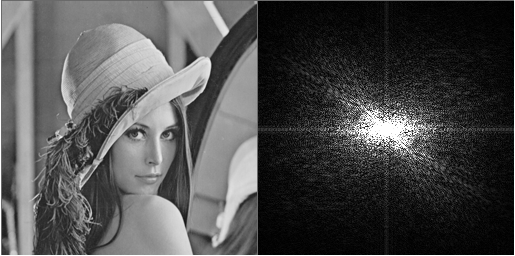
July附注:此傅里叶变换算法,在本BLOG内有深入具体的介绍,请参考本BLOG内其它文章。
六、离散余弦变换
算法描述:
离散余弦变换(DCT for Discrete Cosine Transform)是与傅里叶变换相关的一种变换,它类似于离散傅里叶变换(DFT for Discrete Fourier Transform),但是只使用实数。
离散余弦变换相当于一个长度大概是它两倍的离散傅里叶变换,这个离散傅里叶变换是对一个实偶函数进行的(因为一个实偶函数的傅里叶变换仍然是一个实偶函数),在有些变形里面需要将输入或者输出的位置移动半个单位(DCT有8种标准类型,其中4种是常见的)。
程序实现:
函数名称:FFT()
参数:
complex<double> * TD- 指向时域数组的指针
complex<double> * FD- 指向频域数组的指针
r -2的幂数,即迭代次数
返回值:无。
说明:该函数用来实现快速付立叶变换。
VOID WINAPI FFT(complex<double> * TD, complex<double> * FD, int r)
{
// 付立叶变换点数
LONGcount;
// 循环变量
inti,j,k;
// 中间变量
intbfsize,p;
// 角度
doubleangle;
complex<double> *W,*X1,*X2,*X;
// 计算付立叶变换点数
count = 1 << r;
// 分配运算所需存储器
W = new complex<double>[count / 2];
X1 = new complex<double>[count];
X2 = new complex<double>[count];
// 计算加权系数
for(i = 0; i < count / 2; i++)
{
angle = -i * PI * 2 / count;
W[i] = complex<double> (cos(angle), sin(angle));
}
// 将时域点写入X1
memcpy(X1, TD, sizeof(complex<double>) * count);
// 采用蝶形算法进行快速付立叶变换
for(k = 0; k < r; k++)
{
for(j = 0; j < 1 << k; j++)
{
bfsize = 1 << (r-k);
for(i = 0; i < bfsize / 2; i++)
{
p = j * bfsize;
X2[i + p] = X1[i + p] + X1[i + p + bfsize / 2];
X2[i + p + bfsize / 2] = (X1[i + p] - X1[i + p + bfsize / 2]) * W[i * (1<<k)];
}
}
X = X1;
X1 = X2;
X2 = X;
}
// 重新排序
for(j = 0; j < count; j++)
{
p = 0;
for(i = 0; i < r; i++)
{
if (j&(1<<i))
{
p+=1<<(r-i-1);
}
}
FD[j]=X1[p];
}
// 释放内存
delete W;
delete X1;
delete X2;
}
函数名称:DCT()
参数:
double * f- 指向时域值的指针
double * F- 指向频域值的指针
r-2的幂数
返回值:无。
说明:该函数用来实现快速离散余弦变换,利用2N点的快速付立叶变换来实现离散余弦变换。
VOID WINAPIDCT(double *f, double *F, int r)
{
// 离散余弦变换点数
LONGcount;
// 循环变量
inti;
// 中间变量
doubledTemp;
complex<double> *X;
// 计算离散余弦变换点数
count = 1<<r;
// 分配内存
X = new complex<double>[count*2];
// 赋初值为0
memset(X, 0, sizeof(complex<double>) * count * 2);
// 将时域点写入数组X
for(i=0;i<count;i++)
{
X[i] = complex<double> (f[i], 0);
}
// 调用快速付立叶变换
FFT(X,X,r+1);
// 调整系数
dTemp = 1/sqrt(count);
// 求F[0]
F[0] = X[0].real() * dTemp;
dTemp *= sqrt(2);
// 求F[u]
for(i = 1; i < count; i++)
{
F[i]=(X[i].real() * cos(i*PI/(count*2)) + X[i].imag() * sin(i*PI/(count*2))) * dTemp;
}
// 释放内存
delete X;
}
函数名称:DIBDct()
参数:
LPSTR lpDIBBits - 指向源DIB图像指针
LONG lWidth - 源图像宽度(象素数)
LONG lHeight - 源图像高度(象素数)
返回值:BOOL - 成功返回TRUE,否则返回FALSE。
说明:该函数用来对图像进行离散余弦变换。
BOOL WINAPI DIBDct(LPSTR lpDIBBits, LONG lWidth, LONG lHeight)
{
// 指向源图像的指针
unsigned char*lpSrc;
// 循环变量
LONGi;
LONGj;
// 进行付立叶变换的宽度和高度(2的整数次方)
LONGw;
LONGh;
// 中间变量
doubledTemp;
intwp;
inthp;
// 图像每行的字节数
LONGlLineBytes;
// 计算图像每行的字节数
lLineBytes = WIDTHBYTES(lWidth * 8);
// 赋初值
w = 1;
h = 1;
wp = 0;
hp = 0;
// 计算进行离散余弦变换的宽度和高度(2的整数次方)
while(w * 2 <= lWidth)
{
w *= 2;
wp++;
}
while(h * 2 <= lHeight)
{
h *= 2;
hp++;
}
// 分配内存
double *f = new double[w * h];
double *F = new double[w * h];
// 行
for(i = 0; i < h; i++)
{
// 列
for(j = 0; j < w; j++)
{
// 指向DIB第i行,第j个象素的指针
lpSrc = (unsigned char*)lpDIBBits + lLineBytes * (lHeight - 1 - i) + j;
// 给时域赋值
f[j + i * w] = *(lpSrc);
}
}
for(i = 0; i < h; i++)
{
// 对y方向进行离散余弦变换
DCT(&f[w * i], &F[w * i], wp);
}
// 保存计算结果
for(i = 0; i < h; i++)
{
for(j = 0; j < w; j++)
{
f[j * h + i] = F[j + w * i];
}
}
for(j = 0; j < w; j++)
{
// 对x方向进行离散余弦变换
DCT(&f[j * h], &F[j * h], hp);
}
// 行
for(i = 0; i < h; i++)
{
// 列
for(j = 0; j < w; j++)
{
// 计算频谱
dTemp = fabs(F[j*h+i]);
// 判断是否超过255
if (dTemp > 255)
{
// 对于超过的,直接设置为255
dTemp = 255;
}
// 指向DIB第y行,第x个象素的指针
lpSrc = (unsigned char*)lpDIBBits + lLineBytes * (lHeight - 1 - i) + j;
// 更新源图像
* (lpSrc) = (BYTE)(dTemp);
}
}
// 释放内存
delete f;
delete F;
// 返回
return TRUE;
}
变化效果:
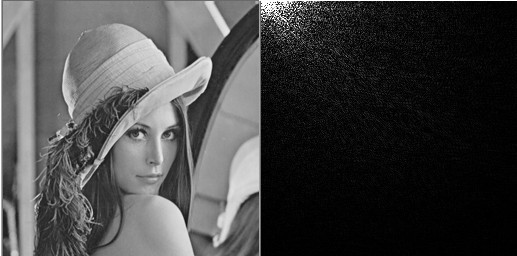
----------------------------------------------
数字图像处理领域的二十四个典型算法及vc实现、第一章
一、256色转灰度图
二、Walsh变换
三、二值化变换
四、阈值变换
五、傅立叶变换
六、离散余弦变换
数字图像处理领域的二十四个典型算法及vc实现、第二章
七、高斯平滑
八、图像平移
九、图像缩放
十、图像旋转
数字图像处理领域的二十四个典型算法及vc实现、第三章
数字图像处理领域的二十四个典型算法及vc实现、第四章
前期回顾:
在上一章,数字图像处理领域的二十四个典型算法及vc实现、第一章中,我们介绍和实现了256色转灰度图、Walsh变换、二值化变换、阈值变换、傅立叶变换、离散余弦变换等数字图像处理领域中的6个典型算法。这一篇接上一篇,继续阐述数字图像处理领域的典型算法。
注,有兴趣具体深入研究的朋友可参考国内外有关此类图像处理算法的优秀论文。
七、高斯平滑
算法描述:
在图像预处理中,对图像进行平滑,去除噪声,恢复原始图像是一个重要内容。本文设计了一个平滑尺度和模板大小均可以改变的高斯滤波器,用它对多幅加入各种噪声后的图像进行平滑,经过对各个结果图像的对比可知高斯滤波对服从正态分布的噪声去除效果比较好,并且相比各个不同参数,在平滑尺度为2,模板大小为7时效果最佳。
程序实现:
函数名称:Template:
参数:HDIB hDIB -图像的句柄
double *tem -指向模板的指针
int tem_w -模板的宽度
int tem_h -模板的高度
double xishu -模板的系数
功能:对图像进行模板操作
说明:为处理方便起见,模板的宽度和高度都应为奇数
HDIB Template(HDIB hDIB,double * tem ,int tem_w,int tem_h,double xishu)
{
//统计中间值
double sum;
//指向图像起始位置的指针
BYTE *lpDIB=(BYTE*)::GlobalLock((HGLOBAL) hDIB);
//指向象素起始位置的指针
BYTE *pScrBuff =(BYTE*)::FindDIBBits((char*)lpDIB);
//获取图像的颜色信息
int numColors=(int) ::DIBNumColors((char *)lpDIB);
//如果图像不是256色返回
if (numColors!=256)
{
//解除锁定
::GlobalUnlock((HGLOBAL) hDIB);
//返回
return(hDIB);
}
//将指向图像象素起始位置的指针,赋值给指针变量
BYTE* oldbuf = pScrBuff;
//循环变量
int i,j,m,n;
int w, h, dw;
//获取图像的宽度
w = (int) ::DIBWidth((char *)lpDIB);
//获取图像的高度
h = (int) ::DIBHeight((char *)lpDIB);
//计算图像每行的字节数
dw = (w+3)/4*4;
//建立一个和原图像大小相同的25色灰度位图
HDIB newhDIB=NewDIB(w,h,8);
//指向新的位图的指针
BYTE *newlpDIB=(BYTE*)::GlobalLock((HGLOBAL) newhDIB);
//指向新的位图的象素起始位置的指针
BYTE *destBuf = (BYTE*)FindDIBBits((char *)newlpDIB);
//将指向新图像象素起始位置的指针,赋值给指针变量
BYTE *newbuf=destBuf;
//对图像进行扫描
//行
for(i=0;i<h;i++)
{
//列
for(j=0;j<w;j++)
{
//为统计变量赋初始值
sum=0;
//对于图像的4个边框的象素保持原灰度不变
if( j<((tem_w-1)/2) || j>(w-(tem_w+1)/2) || i<((tem_h-1)/2) || i>(h-
(tem_h+1)/2) )
*(newbuf+i*dw+j)=*(oldbuf+i*dw+j);
//对于其他的象素进行模板操作
else
{
//将点(i,j)点作为模板的中心
for(m=i-((tem_h-1)/2);m<=i+((tem_h-1)/2);m++)
{
for(n=j-((tem_w-1)/2);n<=j+((tem_w-1)/2);n++)
//将以点(i,j)为中心,与模板大小相同的范围内的象素与模板对用位置的
系数
//进行相乘并线形叠加
sum+=*(oldbuf+m*dw+n)* tem[(m-i+((tem_h-1)/2))*tem_w+n-j+
((tem_w-1)/2)];
}
//将结果乘上总的模板系数
sum=(int)sum*xishu;
//计算绝对值
sum = fabs(sum);
//如果小于0,强制赋值为0
if(sum<0)
sum=0;
//如果大于255,强制赋值为255
if(sum>255)
sum=255;
//将计算的结果放到新的位图的相应位置
*(newbuf+i*dw+j)=sum;
}
}
}
//解除锁定
::GlobalUnlock((HGLOBAL)hDIB);
//返回新的位图的句柄
return(newhDIB);
}
变换效果(图像右边部分即为某一算法的变换效果,下同):


八、图像平移
算法描述:
我想,图像平移,就不必过多介绍了。无非就是通过坐标的增或减的变化,来达到图像在屏幕上的左移、右移、上移、下移的效果。
程序实现:
TranslationDIB--该函数用来水平移动DIB图像。函数不会改变图像的大小,移出的部分图像
将截去,空白部分用白色填充。
下面的左移,右移,上移,下移,各自都调用了此TranslationDIB函数。
//图像平移函数。
BOOL WINAPITranslationDIB(LPSTR lpDIBBits, LONG lWidth, LONG lHeight, LONG
lXOffset, LONG lYOffset)
{
// 指向源图像的指针
LPSTRlpSrc;
// 指向要复制区域的指针
LPSTRlpDst;
// 指向复制图像的指针
LPSTRlpNewDIBBits;
HLOCALhNewDIBBits;
// 象素在新DIB中的坐标
LONGi;
LONGj;
// 象素在源DIB中的坐标
LONGi0;
LONGj0;
// 图像每行的字节数
LONG lLineBytes;
// 计算图像每行的字节数
lLineBytes = WIDTHBYTES(lWidth * 8);
// 暂时分配内存,以保存新图像
hNewDIBBits = LocalAlloc(LHND, lLineBytes * lHeight);
if (hNewDIBBits == NULL)
{
// 分配内存失败
return FALSE;
}
// 锁定内存
lpNewDIBBits = (char * )LocalLock(hNewDIBBits);
// 每行
for(i = 0; i < lHeight; i++)
{
// 每列
for(j = 0; j < lWidth; j++)
{
// 指向新DIB第i行,第j个象素的指针
// 注意由于DIB中图像第一行其实保存在最后一行的位置,因此
lpDst
// 值不是(char *)lpNewDIBBits + lLineBytes * i + j,而是
// (char *)lpNewDIBBits + lLineBytes * (lHeight - 1 - i) +
j
lpDst = (char *)lpNewDIBBits + lLineBytes * (lHeight - 1 -
i) + j;
// 计算该象素在源DIB中的坐标
i0 = i - lXOffset;
j0 = j - lYOffset;
// 判断是否在源图范围内
if( (j0 >= 0) && (j0 < lWidth) && (i0 >= 0) && (i0 <
lHeight))
{
// 指向源DIB第i0行,第j0个象素的指针
// 同样要注意DIB上下倒置的问题
lpSrc = (char *)lpDIBBits + lLineBytes * (lHeight
- 1 - i0) + j0;
// 复制象素
*lpDst = *lpSrc;
}
else
{
// 对于源图中没有的象素,直接赋值为255
* ((unsigned char*)lpDst) = 255;
}
}
}
// 复制平移后的图像
memcpy(lpDIBBits, lpNewDIBBits, lLineBytes * lHeight);
// 释放内存
LocalUnlock(hNewDIBBits);
LocalFree(hNewDIBBits);
// 返回
return TRUE;
}
//向左平移,注:在本程序中,移出去的部分,填充以白色。下同。
void CMyDIPView::OnMenuitem32780()
{
// 平移位图
// 获取文档
CMyDIPDoc* pDoc = GetDocument();
// 指向DIB的指针
LPSTRlpDIB;
// 指向DIB象素指针
LPSTR lpDIBBits;
// 锁定DIB
lpDIB = (LPSTR) ::GlobalLock((HGLOBAL) pDoc->GetHDIB());
// 判断是否是8-bpp位图(这里为了方便,只处理8-bpp位图的平移,其它的可以类
推)
if (::DIBNumColors(lpDIB) != 256)
{
// 提示用户
MessageBox("目前只支持256色位图的平移!", "系统提示" ,
MB_ICONINFORMATION | MB_OK);
// 解除锁定
::GlobalUnlock((HGLOBAL) pDoc->GetHDIB());
// 返回
return;
}
LONG lXOffset;
LONG lYOffset;
// 平移量
lXOffset = -10;
lYOffset = 0;
// 更改光标形状
BeginWaitCursor();
// 找到DIB图像象素起始位置
lpDIBBits = ::FindDIBBits(lpDIB);
//调用TranslationDIB()函数平移DIB
if (TranslationDIB(lpDIBBits, ::DIBWidth(lpDIB), ::DIBHeight(lpDIB),
lXOffset, lYOffset))
{
// 设置脏标记
pDoc->SetModifiedFlag(TRUE);
// 更新视图
pDoc->UpdateAllViews(NULL);
}
else
{
// 提示用户
MessageBox("分配内存失败!", "系统提示" , MB_ICONINFORMATION |
MB_OK);
}
// 解除锁定
::GlobalUnlock((HGLOBAL) pDoc->GetHDIB());
// 恢复光标
EndWaitCursor();
}
//向右平移
void CMyDIPView::OnMenuitem32781()
{
// 平移位图
// 获取文档
CMyDIPDoc* pDoc = GetDocument();
// 指向DIB的指针
LPSTRlpDIB;
// 指向DIB象素指针
LPSTR lpDIBBits;
// 锁定DIB
lpDIB = (LPSTR) ::GlobalLock((HGLOBAL) pDoc->GetHDIB());
// 判断是否是8-bpp位图(这里为了方便,只处理8-bpp位图的平移,其它的可以类
推)
if (::DIBNumColors(lpDIB) != 256)
{
// 提示用户
MessageBox("目前只支持256色位图的平移!", "系统提示" ,
MB_ICONINFORMATION | MB_OK);
// 解除锁定
::GlobalUnlock((HGLOBAL) pDoc->GetHDIB());
// 返回
return;
}
LONG lXOffset;
LONG lYOffset;
// 平移量
lXOffset = 10;
lYOffset = 0;
// 更改光标形状
BeginWaitCursor();
// 找到DIB图像象素起始位置
lpDIBBits = ::FindDIBBits(lpDIB);
// 调用TranslationDIB()函数平移DIB
if (TranslationDIB(lpDIBBits, ::DIBWidth(lpDIB), ::DIBHeight(lpDIB),
lXOffset, lYOffset))
{
// 设置脏标记
pDoc->SetModifiedFlag(TRUE);
// 更新视图
pDoc->UpdateAllViews(NULL);
}
else
{
// 提示用户
MessageBox("分配内存失败!", "系统提示" , MB_ICONINFORMATION |
MB_OK);
}
// 解除锁定
::GlobalUnlock((HGLOBAL) pDoc->GetHDIB());
// 恢复光标
EndWaitCursor();
}
//向上平移
void CMyDIPView::OnMenuitem32779()
{
// 平移位图
// 获取文档
CMyDIPDoc* pDoc = GetDocument();
// 指向DIB的指针
LPSTRlpDIB;
// 指向DIB象素指针
LPSTR lpDIBBits;
// 锁定DIB
lpDIB = (LPSTR) ::GlobalLock((HGLOBAL) pDoc->GetHDIB());
// 判断是否是8-bpp位图(这里为了方便,只处理8-bpp位图的平移,其它的可以类
推)
if (::DIBNumColors(lpDIB) != 256)
{
// 提示用户
MessageBox("目前只支持256色位图的平移!", "系统提示" ,
MB_ICONINFORMATION | MB_OK);
// 解除锁定
::GlobalUnlock((HGLOBAL) pDoc->GetHDIB());
// 返回
return;
}
LONG lXOffset;
LONG lYOffset;
// 平移量
lXOffset = 0;
lYOffset = 10;
// 更改光标形状
BeginWaitCursor();
// 找到DIB图像象素起始位置
lpDIBBits = ::FindDIBBits(lpDIB);
// 调用TranslationDIB()函数平移DIB
if (TranslationDIB(lpDIBBits, ::DIBWidth(lpDIB), ::DIBHeight(lpDIB),
lXOffset, lYOffset))
{
// 设置脏标记
pDoc->SetModifiedFlag(TRUE);
// 更新视图
pDoc->UpdateAllViews(NULL);
}
else
{
// 提示用户
MessageBox("分配内存失败!", "系统提示" , MB_ICONINFORMATION |
MB_OK);
}
// 解除锁定
::GlobalUnlock((HGLOBAL) pDoc->GetHDIB());
// 恢复光标
EndWaitCursor();
}
//向下平移
void CMyDIPView::OnMenuitem32778()
{
// 平移位图
// 获取文档
CMyDIPDoc* pDoc = GetDocument();
// 指向DIB的指针
LPSTRlpDIB;
// 指向DIB象素指针
LPSTR lpDIBBits;
// 锁定DIB
lpDIB = (LPSTR) ::GlobalLock((HGLOBAL) pDoc->GetHDIB());
// 判断是否是8-bpp位图(这里为了方便,只处理8-bpp位图的平移,其它的可以类
推)
if (::DIBNumColors(lpDIB) != 256)
{
// 提示用户
MessageBox("目前只支持256色位图的平移!", "系统提示" ,
MB_ICONINFORMATION | MB_OK);
// 解除锁定
::GlobalUnlock((HGLOBAL) pDoc->GetHDIB());
// 返回
return;
}
LONG lXOffset;
LONG lYOffset;
// 平移量
lXOffset = 0;
lYOffset = -10;
// 更改光标形状
BeginWaitCursor();
// 找到DIB图像象素起始位置
lpDIBBits = ::FindDIBBits(lpDIB);
// 调用TranslationDIB()函数平移DIB
if (TranslationDIB(lpDIBBits, ::DIBWidth(lpDIB), ::DIBHeight(lpDIB),
lXOffset, lYOffset))
{
// 设置脏标记
pDoc->SetModifiedFlag(TRUE);
// 更新视图
pDoc->UpdateAllViews(NULL);
}
else
{
// 提示用户
MessageBox("分配内存失败!", "系统提示" , MB_ICONINFORMATION |
MB_OK);
}
// 解除锁定
::GlobalUnlock((HGLOBAL) pDoc->GetHDIB());
// 恢复光标
EndWaitCursor();
}
变化效果: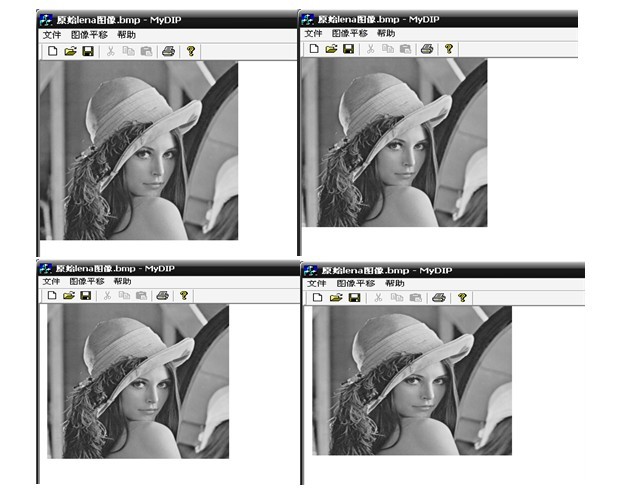
九、图像缩放
算法描述:
I、最邻近插值(近邻取样法):
最临近插值的的思想很简单,对于通过反向变换得到的的一个浮点坐标,对其进行简单的取整,得到一个整数型坐标,这个整数型坐标对应的像素值就是目的像素的像素值,也就是说,取浮点坐标最邻近的左上角点(对于DIB是右上角,因为它的扫描行是逆序存储的)对应的像素值。可见,最邻近插值简单且直观,但得到的图像质量不高。
II、双线性内插值:
对于一个目的像素,设置坐标通过反向变换得到的浮点坐标为(i+u,j+v),其中i、j均为非负整数,u、v为[0,1)区间的浮点数,则这个像素得值 f(i+u,j+v) 可由原图像中坐标为 (i,j)、(i+1,j)、(i,j+1)、(i+1,j+1)所对应的周围四个像素的值决定,即:
f(i+u,j+v) = (1-u)(1-v)f(i,j) + (1-u)vf(i,j+1) + u(1-v)f(i+1,j) + uvf(i+1,j+1)
其中f(i,j)表示源图像(i,j)处的的像素值,以此类推
这就是双线性内插值法。双线性内插值法计算量大,但缩放后图像质量高,不会出现像素值不连续的的情况。由于双线性插值具有低通滤波器的性质,使高频分量受损,所以可能会使图像轮廓在一定程度上变得模糊。
III、三次卷积法能够克服以上两种算法的不足,计算精度高,但计算量大,他考虑一个浮点坐标(i+u,j+v)周围的16个邻点,目的像素值f(i+u,j+v)可由如下插值公式得到:
f(i+u,j+v) = [A] * [B] * [C]
[A]=[ S(u + 1) S(u + 0) S(u - 1) S(u - 2) ]
┏ f(i-1, j-1) f(i-1, j+0) f(i-1, j+1) f(i-1, j+2) ┓
[B]=┃ f(i+0, j-1) f(i+0, j+0) f(i+0, j+1) f(i+0, j+2) ┃
┃ f(i+1, j-1) f(i+1, j+0) f(i+1, j+1) f(i+1, j+2) ┃
┗ f(i+2, j-1) f(i+2, j+0) f(i+2, j+1) f(i+2, j+2) ┛
┏ S(v + 1) ┓
[C]=┃ S(v + 0) ┃
┃ S(v - 1) ┃
┗ S(v - 2) ┛
┏ 1-2*Abs(x)^2+Abs(x)^3 , 0<=Abs(x)<1
S(x)={ 4-8*Abs(x)+5*Abs(x)^2-Abs(x)^3 , 1<=Abs(x)<2
┗ 0 , Abs(x)>=2
S(x)是对 Sin(x*Pi)/x 的逼近(Pi是圆周率——π)
总结:最邻近插值(近邻取样法)、双线性内插值、三次卷积法 等插值算法对于旋转变换、错切变换、一般线性变换 和 非线性变换 都适用。
程序实现:
//该函数用来缩放DIB图像,返回新生成DIB的句柄。
HGLOBAL WINAPIZoomDIB(LPSTR lpDIB, float fXZoomRatio, float fYZoomRatio)
{
// 源图像的宽度和高度
LONGlWidth;
LONGlHeight;
// 缩放后图像的宽度和高度
LONGlNewWidth;
LONGlNewHeight;
// 缩放后图像的宽度(lNewWidth',必须是4的倍数)
LONGlNewLineBytes;
// 指向源图像的指针
LPSTRlpDIBBits;
// 指向源象素的指针
LPSTRlpSrc;
// 缩放后新DIB句柄
HDIBhDIB;
// 指向缩放图像对应象素的指针
LPSTRlpDst;
// 指向缩放图像的指针
LPSTRlpNewDIB;
LPSTRlpNewDIBBits;
// 指向BITMAPINFO结构的指针(Win3.0)
LPBITMAPINFOHEADER lpbmi;
// 指向BITMAPCOREINFO结构的指针
LPBITMAPCOREHEADER lpbmc;
// 循环变量(象素在新DIB中的坐标)
LONGi;
LONGj;
// 象素在源DIB中的坐标
LONGi0;
LONGj0;
// 图像每行的字节数
LONG lLineBytes;
// 找到源DIB图像象素起始位置
lpDIBBits = ::FindDIBBits(lpDIB);
// 获取图像的宽度
lWidth = ::DIBWidth(lpDIB);
// 计算图像每行的字节数
lLineBytes = WIDTHBYTES(lWidth * 8);
// 获取图像的高度
lHeight = ::DIBHeight(lpDIB);
// 计算缩放后的图像实际宽度
// 此处直接加0.5是由于强制类型转换时不四舍五入,而是直接截去小数部分
lNewWidth = (LONG) (::DIBWidth(lpDIB) * fXZoomRatio + 0.5);
// 计算新图像每行的字节数
lNewLineBytes = WIDTHBYTES(lNewWidth * 8);
// 计算缩放后的图像高度
lNewHeight = (LONG) (lHeight * fYZoomRatio + 0.5);
// 分配内存,以保存新DIB
hDIB = (HDIB) ::GlobalAlloc(GHND, lNewLineBytes * lNewHeight + *(LPDWORD)
lpDIB + ::PaletteSize(lpDIB));
// 判断是否内存分配失败
if (hDIB == NULL)
{
// 分配内存失败
return NULL;
}
// 锁定内存
lpNewDIB = (char * )::GlobalLock((HGLOBAL) hDIB);
// 复制DIB信息头和调色板
memcpy(lpNewDIB, lpDIB, *(LPDWORD)lpDIB + ::PaletteSize(lpDIB));
// 找到新DIB象素起始位置
lpNewDIBBits = ::FindDIBBits(lpNewDIB);
// 获取指针
lpbmi = (LPBITMAPINFOHEADER)lpNewDIB;
lpbmc = (LPBITMAPCOREHEADER)lpNewDIB;
// 更新DIB中图像的高度和宽度
if (IS_WIN30_DIB(lpNewDIB))
{
// 对于Windows 3.0 DIB
lpbmi->biWidth = lNewWidth;
lpbmi->biHeight = lNewHeight;
}
else
{
// 对于其它格式的DIB
lpbmc->bcWidth = (unsigned short) lNewWidth;
lpbmc->bcHeight = (unsigned short) lNewHeight;
}
// 针对图像每行进行操作
for(i = 0; i < lNewHeight; i++)
{
// 针对图像每列进行操作
for(j = 0; j < lNewWidth; j++)
{
// 指向新DIB第i行,第j个象素的指针
// 注意此处宽度和高度是新DIB的宽度和高度
lpDst = (char *)lpNewDIBBits + lNewLineBytes * (lNewHeight
- 1 - i) + j;
// 计算该象素在源DIB中的坐标
i0 = (LONG) (i / fYZoomRatio + 0.5);
j0 = (LONG) (j / fXZoomRatio + 0.5);
// 判断是否在源图范围内
if( (j0 >= 0) && (j0 < lWidth) && (i0 >= 0) && (i0 <
lHeight))
{
// 指向源DIB第i0行,第j0个象素的指针
lpSrc = (char *)lpDIBBits + lLineBytes * (lHeight
- 1 - i0) + j0;
// 复制象素
*lpDst = *lpSrc;
}
else
{
// 对于源图中没有的象素,直接赋值为255
* ((unsigned char*)lpDst) = 255;
}
}
}
// 返回
return hDIB;
}
//缩小图像
void CMyDIPView::OnMenuitem32778()
{
// 图像缩放
// 获取文档
CMyDIPDoc* pDoc = GetDocument();
// 指向DIB的指针
LPSTR lpDIB;
// 锁定DIB
lpDIB = (LPSTR) ::GlobalLock((HGLOBAL) pDoc->GetHDIB());
// 判断是否是8-bpp位图(这里为了方便,只处理8-bpp位图的缩放,其它的可以类
推)
if (::DIBNumColors(lpDIB) != 256)
{
// 提示用户
MessageBox("目前只支持256色位图的缩放!", "系统提示" ,
MB_ICONINFORMATION | MB_OK);
// 解除锁定
::GlobalUnlock((HGLOBAL) pDoc->GetHDIB());
// 返回
return;
}
// 缩放比率
float fXZoomRatio;
float fYZoomRatio;
//缩放量
fXZoomRatio = 0.8; //缩小的比率
fYZoomRatio = 0.8;
// 创建新DIB
HDIB hNewDIB = NULL;
// 更改光标形状
BeginWaitCursor();
// 调用ZoomDIB()函数转置DIB
hNewDIB = (HDIB) ZoomDIB(lpDIB, fXZoomRatio, fYZoomRatio);
// 判断缩放是否成功
if (hNewDIB != NULL)
{
// 替换DIB,同时释放旧DIB对象
pDoc->ReplaceHDIB(hNewDIB);
// 更新DIB大小和调色板
pDoc->InitDIBData();
// 设置脏标记
pDoc->SetModifiedFlag(TRUE);
// 重新设置滚动视图大小
SetScrollSizes(MM_TEXT, pDoc->GetDocSize());
// 更新视图
pDoc->UpdateAllViews(NULL);
}
else
{
// 提示用户
MessageBox("分配内存失败!", "系统提示" , MB_ICONINFORMATION |
MB_OK);
}
// 解除锁定
::GlobalUnlock((HGLOBAL) pDoc->GetHDIB());
// 恢复光标
EndWaitCursor();
}
//放大图像
void CMyDIPView::OnMenuitem32779()
{
// 图像缩放
// 获取文档
CMyDIPDoc* pDoc = GetDocument();
// 指向DIB的指针
LPSTR lpDIB;
// 锁定DIB
lpDIB = (LPSTR) ::GlobalLock((HGLOBAL) pDoc->GetHDIB());
// 判断是否是8-bpp位图(这里为了方便,只处理8-bpp位图的缩放,其它的可以类
推)
if (::DIBNumColors(lpDIB) != 256)
{
// 提示用户
MessageBox("目前只支持256色位图的缩放!", "系统提示" ,
MB_ICONINFORMATION | MB_OK);
// 解除锁定
::GlobalUnlock((HGLOBAL) pDoc->GetHDIB());
// 返回
return;
}
// 缩放比率
float fXZoomRatio;
float fYZoomRatio;
//缩放量
fXZoomRatio = 1.25; //放大的比率
fYZoomRatio = 1.25;
// 创建新DIB
HDIB hNewDIB = NULL;
// 更改光标形状
BeginWaitCursor();
// 调用ZoomDIB()函数转置DIB
hNewDIB = (HDIB) ZoomDIB(lpDIB, fXZoomRatio, fYZoomRatio);
// 判断缩放是否成功
if (hNewDIB != NULL)
{
// 替换DIB,同时释放旧DIB对象
pDoc->ReplaceHDIB(hNewDIB);
// 更新DIB大小和调色板
pDoc->InitDIBData();
// 设置脏标记
pDoc->SetModifiedFlag(TRUE);
// 重新设置滚动视图大小
SetScrollSizes(MM_TEXT, pDoc->GetDocSize());
// 更新视图
pDoc->UpdateAllViews(NULL);
}
else
{
// 提示用户
MessageBox("分配内存失败!", "系统提示" , MB_ICONINFORMATION |
MB_OK);
}
// 解除锁定
::GlobalUnlock((HGLOBAL) pDoc->GetHDIB());
// 恢复光标
EndWaitCursor();
}
变换效果(找到参照物判断):
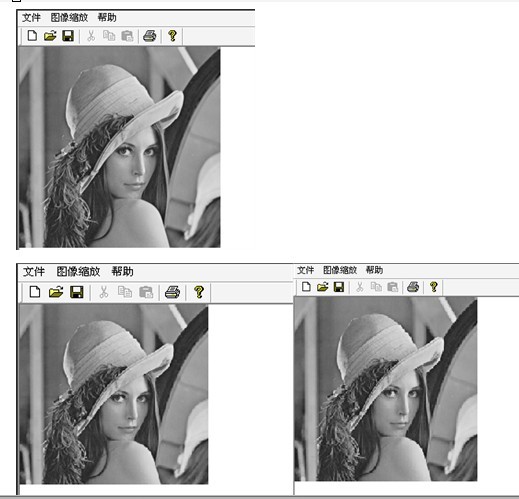
十、图像旋转
算法描述:图像旋转算法原理,可参见:http://hi.baidu.com/wangguang246/blog/item/124b9219981f530d35fa41ca.html。
程序实现:
//角度到弧度转化的宏
#define RADIAN(angle) ((angle)*PI/180.0)
函数名称:RotateDIB()
参数:
LPSTR lpDIB- 指向源DIB的指针
int iRotateAngle- 旋转的角度(0-360度)
返回值:HGLOBAL - 旋转成功返回新DIB句柄,否则返回NULL。
说明:该函数用来以图像中心为中心旋转DIB图像,返回新生成DIB的句柄。调用该函数会自动
扩大图像以显示所有的象素。函数中采用最邻近插值算法进行插值。
HGLOBAL WINAPIRotateDIB(LPSTR lpDIB, int iRotateAngle)
{
// 源图像的宽度和高度
LONGlWidth;
LONGlHeight;
// 旋转后图像的宽度和高度
LONGlNewWidth;
LONGlNewHeight;
// 图像每行的字节数
LONGlLineBytes;
// 旋转后图像的宽度(lNewWidth',必须是4的倍数)
LONGlNewLineBytes;
// 指向源图像的指针
LPSTRlpDIBBits;
// 指向源象素的指针
LPSTRlpSrc;
// 旋转后新DIB句柄
HDIBhDIB;
// 指向旋转图像对应象素的指针
LPSTRlpDst;
// 指向旋转图像的指针
LPSTRlpNewDIB;
LPSTRlpNewDIBBits;
// 指向BITMAPINFO结构的指针(Win3.0)
LPBITMAPINFOHEADER lpbmi;
// 指向BITMAPCOREINFO结构的指针
LPBITMAPCOREHEADER lpbmc;
// 循环变量(象素在新DIB中的坐标)
LONGi;
LONGj;
// 象素在源DIB中的坐标
LONGi0;
LONGj0;
// 旋转角度(弧度)
floatfRotateAngle;
// 旋转角度的正弦和余弦
floatfSina, fCosa;
// 源图四个角的坐标(以图像中心为坐标系原点)
floatfSrcX1,fSrcY1,fSrcX2,fSrcY2,fSrcX3,fSrcY3,fSrcX4,fSrcY4;
// 旋转后四个角的坐标(以图像中心为坐标系原点)
floatfDstX1,fDstY1,fDstX2,fDstY2,fDstX3,fDstY3,fDstX4,fDstY4;
// 两个中间常量
floatf1,f2;
// 找到源DIB图像象素起始位置
lpDIBBits = ::FindDIBBits(lpDIB);
// 获取图像的"宽度"(4的倍数)
lWidth = ::DIBWidth(lpDIB);
// 计算图像每行的字节数
lLineBytes = WIDTHBYTES(lWidth * 8);
// 获取图像的高度
lHeight = ::DIBHeight(lpDIB);
// 将旋转角度从度转换到弧度
fRotateAngle = (float) RADIAN(iRotateAngle);
// 计算旋转角度的正弦
fSina = (float) sin((double)fRotateAngle);
// 计算旋转角度的余弦
fCosa = (float) cos((double)fRotateAngle);
// 计算原图的四个角的坐标(以图像中心为坐标系原点)
fSrcX1 = (float) (- (lWidth - 1) / 2);
fSrcY1 = (float) ( (lHeight - 1) / 2);
fSrcX2 = (float) ( (lWidth - 1) / 2);
fSrcY2 = (float) ( (lHeight - 1) / 2);
fSrcX3 = (float) (- (lWidth - 1) / 2);
fSrcY3 = (float) (- (lHeight - 1) / 2);
fSrcX4 = (float) ( (lWidth - 1) / 2);
fSrcY4 = (float) (- (lHeight - 1) / 2);
// 计算新图四个角的坐标(以图像中心为坐标系原点)
fDstX1 = fCosa * fSrcX1 + fSina * fSrcY1;
fDstY1 = -fSina * fSrcX1 + fCosa * fSrcY1;
fDstX2 = fCosa * fSrcX2 + fSina * fSrcY2;
fDstY2 = -fSina * fSrcX2 + fCosa * fSrcY2;
fDstX3 = fCosa * fSrcX3 + fSina * fSrcY3;
fDstY3 = -fSina * fSrcX3 + fCosa * fSrcY3;
fDstX4 = fCosa * fSrcX4 + fSina * fSrcY4;
fDstY4 = -fSina * fSrcX4 + fCosa * fSrcY4;
// 计算旋转后的图像实际宽度
lNewWidth = (LONG) ( max( fabs(fDstX4 - fDstX1), fabs(fDstX3 - fDstX2) )
+ 0.5);
// 计算新图像每行的字节数
lNewLineBytes = WIDTHBYTES(lNewWidth * 8);
// 计算旋转后的图像高度
lNewHeight = (LONG) ( max( fabs(fDstY4 - fDstY1), fabs(fDstY3 - fDstY2) )
+ 0.5);
// 两个常数,这样不用以后每次都计算了
f1 = (float) (-0.5 * (lNewWidth - 1) * fCosa - 0.5 * (lNewHeight - 1) *
fSina
+ 0.5 * (lWidth - 1));
f2 = (float) ( 0.5 * (lNewWidth - 1) * fSina - 0.5 * (lNewHeight - 1) *
fCosa
+ 0.5 * (lHeight - 1));
// 分配内存,以保存新DIB
hDIB = (HDIB) ::GlobalAlloc(GHND, lNewLineBytes * lNewHeight + *(LPDWORD)
lpDIB + ::PaletteSize(lpDIB));
// 判断是否内存分配失败
if (hDIB == NULL)
{
// 分配内存失败
return NULL;
}
// 锁定内存
lpNewDIB = (char * )::GlobalLock((HGLOBAL) hDIB);
// 复制DIB信息头和调色板
memcpy(lpNewDIB, lpDIB, *(LPDWORD)lpDIB + ::PaletteSize(lpDIB));
// 找到新DIB象素起始位置
lpNewDIBBits = ::FindDIBBits(lpNewDIB);
// 获取指针
lpbmi = (LPBITMAPINFOHEADER)lpNewDIB;
lpbmc = (LPBITMAPCOREHEADER)lpNewDIB;
// 更新DIB中图像的高度和宽度
if (IS_WIN30_DIB(lpNewDIB))
{
// 对于Windows 3.0 DIB
lpbmi->biWidth = lNewWidth;
lpbmi->biHeight = lNewHeight;
}
else
{
// 对于其它格式的DIB
lpbmc->bcWidth = (unsigned short) lNewWidth;
lpbmc->bcHeight = (unsigned short) lNewHeight;
}
// 针对图像每行进行操作
for(i = 0; i < lNewHeight; i++)
{
// 针对图像每列进行操作
for(j = 0; j < lNewWidth; j++)
{
// 指向新DIB第i行,第j个象素的指针
// 注意此处宽度和高度是新DIB的宽度和高度
lpDst = (char *)lpNewDIBBits + lNewLineBytes * (lNewHeight
- 1 - i) + j;
// 计算该象素在源DIB中的坐标
i0 = (LONG) (-((float) j) * fSina + ((float) i) * fCosa +
f2 + 0.5);
j0 = (LONG) ( ((float) j) * fCosa + ((float) i) * fSina +
f1 + 0.5);
// 判断是否在源图范围内
if( (j0 >= 0) && (j0 < lWidth) && (i0 >= 0) && (i0 <
lHeight))
{
// 指向源DIB第i0行,第j0个象素的指针
lpSrc = (char *)lpDIBBits + lLineBytes * (lHeight
- 1 - i0) + j0;
// 复制象素
*lpDst = *lpSrc;
}
else
{
// 对于源图中没有的象素,直接赋值为255
* ((unsigned char*)lpDst) = 255;
}
}
}
// 返回
return hDIB;
}
//顺时针旋转
void CMyDIPView::OnMenuitem32778()
{
// 图像旋转
// 获取文档
CMyDIPDoc* pDoc = GetDocument();
// 指向DIB的指针
LPSTR lpDIB;
// 锁定DIB
lpDIB = (LPSTR) ::GlobalLock((HGLOBAL) pDoc->GetHDIB());
// 判断是否是8-bpp位图(这里为了方便,只处理8-bpp位图的旋转,其它的可以类
推)
if (::DIBNumColors(lpDIB) != 256)
{
// 提示用户
MessageBox("目前只支持256色位图的旋转!", "系统提示" ,
MB_ICONINFORMATION | MB_OK);
// 解除锁定
::GlobalUnlock((HGLOBAL) pDoc->GetHDIB());
// 返回
return;
}
// 旋转角度
int iRotateAngle;
iRotateAngle=15;
// 创建新DIB
HDIB hNewDIB = NULL;
// 更改光标形状
BeginWaitCursor();
// 调用RotateDIB()函数旋转DIB
hNewDIB = (HDIB) RotateDIB(lpDIB, iRotateAngle);
// 判断旋转是否成功
if (hNewDIB != NULL)
{
// 替换DIB,同时释放旧DIB对象
pDoc->ReplaceHDIB(hNewDIB);
// 更新DIB大小和调色板
pDoc->InitDIBData();
// 设置脏标记
pDoc->SetModifiedFlag(TRUE);
// 重新设置滚动视图大小
SetScrollSizes(MM_TEXT, pDoc->GetDocSize());
// 更新视图
pDoc->UpdateAllViews(NULL);
}
else
{
// 提示用户
MessageBox("分配内存失败!", "系统提示" , MB_ICONINFORMATION |
MB_OK);
}
// 解除锁定
::GlobalUnlock((HGLOBAL) pDoc->GetHDIB());
// 恢复光标
EndWaitCursor();
}
//逆时针旋转
void CMyDIPView::OnMenuitem32779()
{
// 图像旋转
// 获取文档
CMyDIPDoc* pDoc = GetDocument();
// 指向DIB的指针
LPSTR lpDIB;
// 锁定DIB
lpDIB = (LPSTR) ::GlobalLock((HGLOBAL) pDoc->GetHDIB());
// 判断是否是8-bpp位图(这里为了方便,只处理8-bpp位图的旋转,其它的可以类
推)
if (::DIBNumColors(lpDIB) != 256)
{
// 提示用户
MessageBox("目前只支持256色位图的旋转!", "系统提示" ,
MB_ICONINFORMATION | MB_OK);
// 解除锁定
::GlobalUnlock((HGLOBAL) pDoc->GetHDIB());
// 返回
return;
}
// 旋转角度
int iRotateAngle;
iRotateAngle=-15;
// 创建新DIB
HDIB hNewDIB = NULL;
// 更改光标形状
BeginWaitCursor();
// 调用RotateDIB()函数旋转DIB
hNewDIB = (HDIB) RotateDIB(lpDIB, iRotateAngle);
// 判断旋转是否成功
if (hNewDIB != NULL)
{
// 替换DIB,同时释放旧DIB对象
pDoc->ReplaceHDIB(hNewDIB);
// 更新DIB大小和调色板
pDoc->InitDIBData();
// 设置脏标记
pDoc->SetModifiedFlag(TRUE);
// 重新设置滚动视图大小
SetScrollSizes(MM_TEXT, pDoc->GetDocSize());
// 更新视图
pDoc->UpdateAllViews(NULL);
}
else
{
// 提示用户
MessageBox("分配内存失败!", "系统提示" , MB_ICONINFORMATION |
MB_OK);
}
// 解除锁定
::GlobalUnlock((HGLOBAL) pDoc->GetHDIB());
// 恢复光标
EndWaitCursor();
}
变化效果:























 9735
9735

 被折叠的 条评论
为什么被折叠?
被折叠的 条评论
为什么被折叠?








